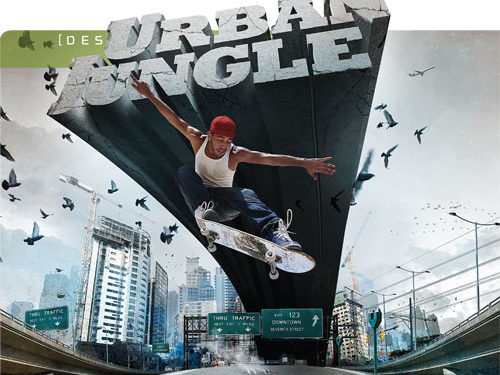Designer Spotlight: Mike Campau

Mike Campau knew he wanted to be an artist after he won a McDonald’s drawing contest at the age of three. He was enrolled in art classes by the age of six, so it came as no surprise when he entered into the scientific illustration program at the University of Michigan. The program didn’t challenge him creatively, however, so he switched to graphic design within the first year. In 1997 Mike started at SeventhStreet (www.seventhstreetstudio.com) as a junior retoucher and digital artist, and in just two short years, he became their creative director, a title he still holds today. Mike’s captivating work has been published in numerous magazines and books, including Advanced Photoshop magazine, Computer Graphics World, Photoshop User magazine, and Secrets of Poser Experts. As creative director of SeventhStreet, he has worked with clients such as Chevrolet, Ford, Minute Maid, Quaker State, Nescafé, and many more. He also designed the boxes for Poser 7 and 8.

Layers: What are the advantages (or disadvantages) to working for the same design studio for the past 12 years?
Campau: The biggest advantage is knowing the people I work with. Over the 12-year span, I’ve worked with the same key people at SeventhStreet to refine and develop a creative process and workflow that’s become second nature to me. On the other hand, working at the same place for a long period of time makes it harder to get an outside perspective and creative input. I work with some talented designers, retouchers, and 3D artists, but we work together every day, so we sometimes take each other for granted creatively. That’s why I’m always on the lookout for outside collaborations or freelance projects that let me work on digital art and imaging that I wouldn’t normally work on at the studio.
Layers: As creative director at SeventhStreet, are you involved in every project that comes through the studio from the client brief to the finished product?
Campau: Yes, I’m involved on every project that comes through the studio, as well as any creative marketing and self-promotion. There are some projects I work on from start to finish, usually the more complex and challenging projects. Then there are other projects that I review along the way and make sure it’s up to our creative standards before it leaves our studio. At SeventhStreet, everyone knows how to do just about everything, but everyone has their own specialties and it’s my job to make sure the right people are working on the right aspect of the project.

Layers: How has SeventhStreet attracted and maintained some of its bigger clients?
Campau: SeventhStreet is big on collaboration with our clients. We don’t take ourselves too seriously and really are here to work with them and help as much as we can. We try to convey this message in all of our marketing because we think it’s more than just making good images; it’s making our clients happy. We also try to keep a wide range of styles and images in our portfolio, and I think most of our clients can find something that relates to their project.
Layers: When did you first discover Photoshop, and how did you learn to master it?
Campau: I discovered Photoshop in 1991 when there were no layers, one undo, and it was software that came bundled with a scanner. My knowledge has come through many different resources: classes and workshops, co-workers, online tips and tutorials, and a lot of trial and error. There are hundreds of ways to do the same thing in Photoshop, but I always strive to find the fastest way to accomplish the result. I also tell people new to Photoshop to not be afraid to try anything—there’s always an undo.
Layers: You use a lot of 3D tools in your work to create realistic CG images. What are the advantages of using CG in your projects?
Campau: With CG you’re not limited by the laws of physics; some shots you just couldn’t create in photography. That doesn’t mean you should use CG for everything—just think of it as another tool to create the end product. I would have to say that most of my work is 50/50 CG to photography because I feel that to make the CG look completely believable, it needs some real-world influence to trick the eye. Once you’ve achieved this perfect balance you can fool almost anyone. My Poser human figures, however, are all CG and Photoshop painting (no photography) and I take great pride in fooling fellow photographers with some of my portraits.

Layers: What’s your secret for staying fresh creatively?
Campau: I’m always searching for new ideas in imaging, and I’m never satisfied with my own skill set. Whenever I see an image I like, I ask myself, “How would I make that, and how could I make it better?” Every day I try to review design blogs, online creative groups, and keep up to date on the latest in photography. If I’m ever feeling creatively stale, I’ll reach out to a fellow artist or photographer—working with another talented artist tends to push you even further than working alone.

Mike Campau www.seventhstreetstudio.com
ALL IMAGES BY MIKE CAMPAU

